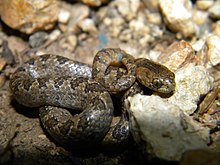Geophis sanniolus, commonly known as the pygmy snail-eating snake or the pygmy snail sucker, is a species of small snake in the family Colubridae. The species is endemic to Central America and southeastern Mexico.
| Geophis sanniolus | |
|---|---|

| |
| Scientific classification | |
| Domain: | Eukaryota |
| Kingdom: | Animalia |
| Phylum: | Chordata |
| Class: | Reptilia |
| Order: | Squamata |
| Suborder: | Serpentes |
| Family: | Colubridae |
| Genus: | Geophis |
| Species: | G. sanniolus
|
| Binomial name | |
| Geophis sanniolus (Cope, 1866)
| |
| Synonyms[2] | |
Geographic range
editG. sanniolus is found in Belize, Guatemala, and the Mexican states of Campeche, Quintana Roo, and Yucatán.[1][2][3]
Habitat
editGeophis sanniolus is a relatively common snake that occurs in tropical semi-deciduous forest and thorn forest, and also in degraded forest.[1]
Reproduction
editG. sanniolus reaches sexual maturity in eight months and produces a single clutch per year.[4]
Subspecies
editTwo subspecies are recognized as being valid, including the nominotypical subspecies.[2]
- Geophis sanniolus neilli Henderson, Hoevers & Wilson, 1977
- Geophis sanniolus sanniolus (Cope, 1866)
Nota bene: A trinomial authority or a binomial authority in parentheses indicates that the subspecies or species was originally described in a genus other than Geophis.
Etymology
editThe subspecific name, neilli, is in honor of American herpetologist Wilfred T. Neill.[5]
References
edit- ^ a b c Lee, J.; Calderón Mandujano, R. (2013). "Sibon sanniolus". IUCN Red List of Threatened Species. 2013: e.T63920A3131114. doi:10.2305/IUCN.UK.2013-2.RLTS.T63920A3131114.en. Retrieved 19 November 2021.
- ^ a b c Geophis sanniolus at the Reptarium.cz Reptile Database. Accessed 19 April 2015.
- ^ Campbell JA (1999). Amphibians and Reptiles of Northern Guatemala, the Yucatan, and Belize. Norman, Oklahoma: University of Oklahoma Press. pp. 243–244. ISBN 978-0-8061-3066-8.
- ^ Zug GR [in German] (1993). An Introductory Biology of Amphibians and Reptiles. Academic Press. p. 150. ISBN 978-0-12-782622-6.
- ^ Beolens, Bo; Watkins, Michael; Grayson, Michael (2011). The Eponym Dictionary of Reptiles. Baltimore: Johns Hopkins University Press. xiii + 296 pp. ISBN 978-1-4214-0135-5. (Sibon sanniolus neilli, p. 188).
Further reading
edit- Cope ED (1866). "Fifth Contribution to the Herpetology of Tropical America". Proc. Acad. Nat. Sci. Philadelphia 1886: 317–323. (Mesopeltis sanniolus, new species, p. 318).
- Boulenger GA (1896). Catalogue of the Snakes in the British Museum (Natural History). Volume III., Containing the Colubridæ (Opisthoglyphæ and Proteroglyphæ), Amblycephalidæ, and Viperidæ. London: Trustees of the British Museum (Natural History). (Taylor and Francis, printers). xiv + 727 pp. + Plates I-XXV. (Leptognathus sanniola, p. 459).
- Heimes, Peter (2016). Snakes of Mexico: Herpetofauna Mexicana Vol. I. Frankfurt, Germany: Chimaira. 572 pp. ISBN 978-3899731002.
